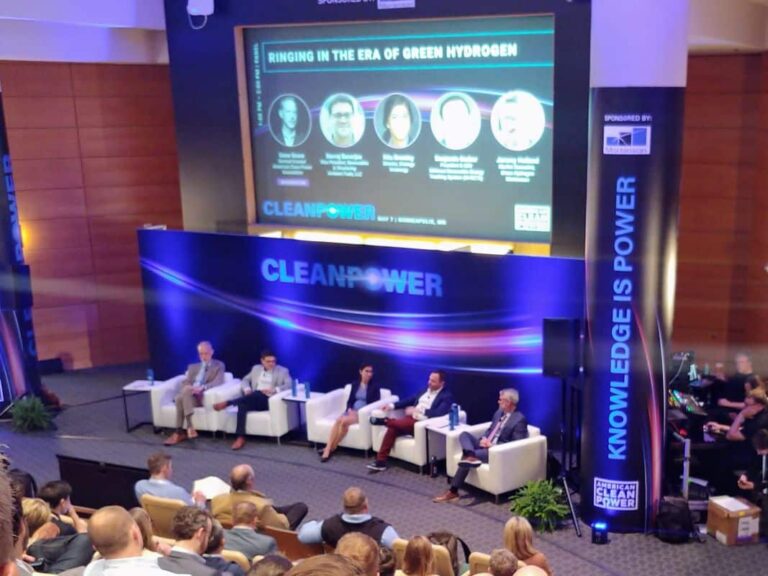The annual one CLEANPOWER conference and exhibition brings together a large cross-section of the large-scale renewable energy industry, including solar, wind and green hydrogen. Hosted by the American Clean Power Association (ACP) on May 6 and 9 at the Minneapolis Convention Center in Minnesota, the event attracts more than 8,300 visitors from all over the world.
I was there to keep up with the latest news and trends in large-scale solar energy development. While I will report in more depth in the coming months, here are my overall takeaways from the conference.
Major changes: DOE rules for transmission permits
Building new transmission lines to connect clean energy projects to the grid was a major topic at the conference.
On May 8, I attended a panel titled “Not Just Lines on a Map: Moving Transmission Forward,” moderated by Kelly Speakes-Backman, executive VP of public affairs at Invenergy, with speakers including Jayni Hein, advisor and co-chair of carbon management. and climate mitigation at Covington & Burling; Al Vickers, chief operating officer at Grid United; Samuel Walsh, general counsel at the U.S. Department of Energy.
The discussion focused on the April 25 news that the DOE had released its final transmission permit rule, allowing the Coordinated Interagency Transmission Authorizations and Permits (CITAP) program. The CITAP program aims to improve federal environmental assessments and permitting processes for qualifying transmission projects.
Walsh explained that the focus on energy transmission within the DOE has improved over the past decade, explaining that “the DOE is now establishing schedules for environmental permitting.”
Under the program, the DOE coordinates with other federal agencies to expedite environmental reviews and authorizations within a standard two-year schedule.
In addition, Walsh discussed that the Biden-Harris administration had allocated up to $331 million to add more than 2,000 MW of additional grid capacity in the western United States.
Vickers noted that “it seems like there is more momentum in the transfer,” describing a “chicken and the egg” scenario when it comes to project permitting and stakeholder engagement (i.e., it’s hard to do one without the to have another, but which comes first? ), but the changes at the DOE allowed the project to move forward.
“What has changed is that the DOE now has a set of tools to overcome the chicken-and-egg scenario, and that has been very helpful,” Vickers said.
Big Gain: Utility Scale Shines in Q1
The people of ACP organized a press conference on May 7 to share the association’s new ACP activities Quarterly Clean Energy Market Report | Q1 2024. In an impressive start to the year, the report shows that the U.S. utility-scale solar, wind and storage sectors added a combined 5,585 MW of new capacity in the first quarter of 2024, up 28% compared to installations in the same quarter. period a year ago.
As a leader, utility-scale solar energy reached an important milestone: the operating capacity of 100 GW was exceeded for the first time. John Hensley, ACP’s VP of Markets and Policy Analysis, said it took 18 years to build the first 50 GW of solar capacity in the US, but only four years to double it.
A whopping 4,557 MW of new solar capacity was added in the first quarter of 2024, helping to boost the U.S. to more than 100,547 MW of installed utility-scale solar, with nearly 40% of that newly installed capacity coming online in Florida.
“The first quarter of 2024 set the pace for the year and underlined both an industry that continues to break barriers and the increasing demand for clean energy solutions,” said Hensley. “Crossing the 100 GW solar milestone, launching breakthrough projects like South Fork Wind, and a record pace of new clean energy contracts are clear indicators of the public’s demand to strengthen the electric grid with domestic, reliable and affordable clean energy.”

Another big highlight was the increase in clean energy purchasing, with a 52% jump from the first quarter of 2023, with 7,773 MW of new Power Purchase Agreements (PPAs) as utilities and corporate buyers pursue renewables to to power their businesses.
Additionally, the ACS reported that the clean energy pipeline has expanded to nearly 175 GW – the most ever recorded. Most of this expansion can be attributed to battery storage and solar, which have grown at an average of 11% and 4% per quarter since the second quarter of 2022.
While energy storage deployment was flat compared to the same period last year, the pipeline for new storage projects increased 61% year-on-year to 31.6 GW in the near term, indicating strong future growth.
Responding to concerns about the 2024 presidential election and potential uncertainty in the market, Hensley said the key fundamentals of the clean energy market are strong.
“There is strong demand from corporate buyers,” he says. “We are seeing investments in all 50 states, which will enhance the longevity of the market.”
Big market: data centers for AI
A common theme I’ve heard from many sources at CLEANPOWER is the development of solar farms that power data centers to facilitate AI. It turns out that your ChatGPT, DALL-E, and deepfake programs require a huge amount of power to run their computing services.
Hanson Wood, head of onshore renewables development at RWE, explained that major companies such as Microsoft and Google are looking to power increasingly larger data centers, but they still have corporate social responsibility objectives. To gain the power needed to support these AI facilities, Wood added that hybrid renewable projects could be the answer.
“The computing power needed to support [AI] is really unlike anything we’ve ever seen, in terms of the demand that would be required to help sustain that and grow,” he said. “There are two characteristics. You see that data centers will become larger than before. And the product offering that customers are looking for is more 24-hour renewable energy, which necessarily has to be multi-technology combinations, so solar plus storage plus wind.”
Big question: Green hydrogen
The conference hosted a session on the green hydrogen market on May 7. Gene Grace, ACS general counsel, served as moderator for the “Ringing in the Era of Green Hydrogen” panel, which also included Jeremy Holland, PE, market manager at Mortenson; Ben Gerber, president and CEO of Midwest Renewable Energy Tracking System (M-RETS); Devraj Banerjee, VP of sustainable energy and structuring at Ambient Fuels LLC; and Ritu Bromley, director of strategy at Invenergy.
Banerjee and Bromley explained how the industrial and chemical industries are major supporters of the interest in green hydrogen to decarbonize manufacturing and production facilities, such as steel mills, and serve as a raw material for chemical products.
One of the ongoing challenges is how we can make green hydrogen a sustainable reality.
“There is a saying: hydrogen is the fuel of the future, and it always will be,” says Gerber.
Another challenge for investors is the uncertainty surrounding the 45V investment tax credits (ITC), with issues related to hourly matching and renewable energy credits (RECs).
The panelists discussed how green hydrogen can be linked to clean energy hubs, or hybrid facilities that combine solar, wind and green hydrogen production.
In a separate conversation with Sandhya Ganapathy, CEO of EDP Renewables, I learned that the green hydrogen market in Europe is already further along. She explained how EDP Renewables has had success co-locating green hydrogen plants with wind and solar energy, similar to the clean energy hubs mentioned above.
“From a location perspective, these are all industrial hubs, so we’ve obviously updated the network,” she said. “As far as the US is concerned, I started looking at it. The challenge in the US, of course, is that we need some clarity on the essence of it. But I think the biggest challenge we have here is that the US is such a big country, so in terms of transportation, how do we actually move the green hydrogen from where you produce it to where you actually use it?”[thegrid”shesaid“AsfarasintheUSIhavestartedlookingatitThechallengeintheUSisofcoursewedoneedsomeclarityaroundthebottomlineofitButIthinkthebiggestchallengethatwehaveheristheUSissuchalargecountrysointermsoftransportationhowdoweactuallymovethegreenhydrogenfromwhereyou’reproducingittowhereyou’reactuallyusingit?”[thegrid”shesaid“AsfarasintheUSIhavestartedlookingatitThechallengeintheUSisofcoursewedoneedsomeclarityaroundthebottomlineofitButIthinkthebiggestchallengethatwehavehereistheUSissuchalargecountrysointermsoftransportationhowdoweactuallymovethegreenhydrogenfromwhereyou’reproducingittowhereyou’reactuallyusingit?”
Small fun: Live painting

As I strolled through the expo hall during CLEANPOWER, I noticed a pile of tarpaulins surrounding these teardrop-shaped bench structures. As I got closer, I saw a woman with a brush adding decoration to the otherwise dull constructions.
It was a nice bit of entertainment and nice to see some art being performed in between all the business matters.
Two facts: as seen at CLEANPOWER
Don’t miss our report on LONGi’s new module that prevents hail damage.
Don’t miss our report on Nevados’ ranking among the best installation efficiency trackers.
Listen to more in-depth conversations on Solar Builder’s YouTube channel

Our most popular series include:
Power forward! | A collaboration with BayWa re to discuss industrial topics at a higher level.
The buzz | Where we give our 2 cents per kWh in the residential solar market.
The pitch | Discussions with solar manufacturers about their new technology and ideas.
Source link


